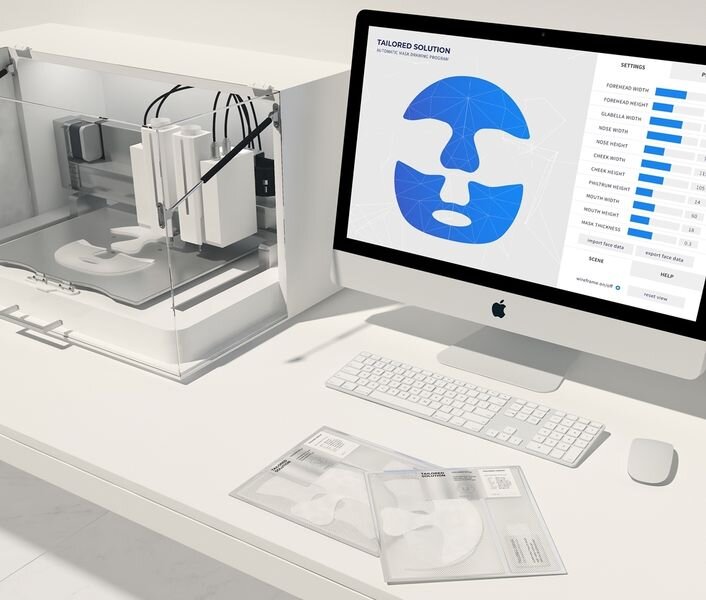![3D printed facial masks [Source: Korea Herald]](https://fabbaloo.com/wp-content/uploads/2020/05/image-asset_img_5eb08c0bae911.jpg)
An application I’d never have imagined being developed has been announced at CES by Amore Pacific, a large Korean cosmetics company.
The system, known as the “3D Printing Mask Pack”, offers an ability to rapidly produce customized face masks.
Hold on, there’s a bit of background required here for those unfamiliar with the concept of facial masks. These are masks made from hydrogel that are designed to be placed on one’s face. The application allows cleaning chemicals and other materials to be delivered to the right places on the face simply because of the geometry of the mask. Then, after a suitable time period, the mask is peeled off and disposed.
Custom Facial Masks
The problem apparently is that the mass-manufactured facial masks make assumptions about the face shapes and thus they don’t always fit optimally on purchaser’s faces.
The innovation here is that Amore Pacific has partnered with Lincsolution to create a device that can prepare custom facial masks on demand with little waiting. They say:
“High speed 3D printer for in-store services -Existing FFF type 3D printer that outputs hydrogel suitable for skin usually takes tens of minutes to several hours to print a single product, which has a limitation as customers cannot get their products on site. To overcome these limitations, 3D printers for custom mask packs are optimized to print one hydrogel mask pack within minutes (typically within 5 minutes), which makes it possible to fully utilize them in the store environment.”
3D Scanning Facial Attributes
Their approach is to use 3D scanning to collect information about the subject, which apparently includes not only geometry, but also “age, race, gender and living environment”. I’m not quite sure what that last item means, but the others are possibly derivable from 3D scans.
In the image at top you can see various factors involved in the 3D model generation, including:
-
Forehead width
-
Forehead height
-
Glabella width (“the smooth part of the forehead above and between the eyebrows
-
Nose width
-
Nose height
-
Cheek width
-
Cheek height
-
Philtrum height (the “vertical indentation in the middle area of the upper lip”)
-
Mouth width
-
Mouth height
-
Mask thickness
They’re attempting to match the print to the specific skin needs of the subject. This should be of interest to those who don’t happen to fit the standard mass produced facial masks offered today.
This is an example of a customized consumer product enabled by 3D printing. In the past we’ve seen this approach used to capture foot geometry to enable production of custom 3D printed shoes, as well as face scanning to 3D print eyewear.
Materialise Relationship?
What’s interesting is that both of the application I mention above were powered under the hood by sophisticated software from Materialise, who have developed tools specifically for this type of situation. It’s not mentioned whether they’re involved with Amore Pacific in this venture, but it turns out that Materialise has indeed done work with Lincsolutions in the past, so it could be the case.
This solution is by no means one for consumers, as it seems to be set up for use by commercial beauty operations for visiting clients. This is similar to what has been seen for custom shoe and eyewear kiosk installations.
Future Custom Consumer Products
I’m hoping there are more applications of this type identified, as it will help persuade the public that custom produced products are a natural thing to expect. If that happens, then we’ll see a lot more 3D printing.
Via CES and Korea Herald

